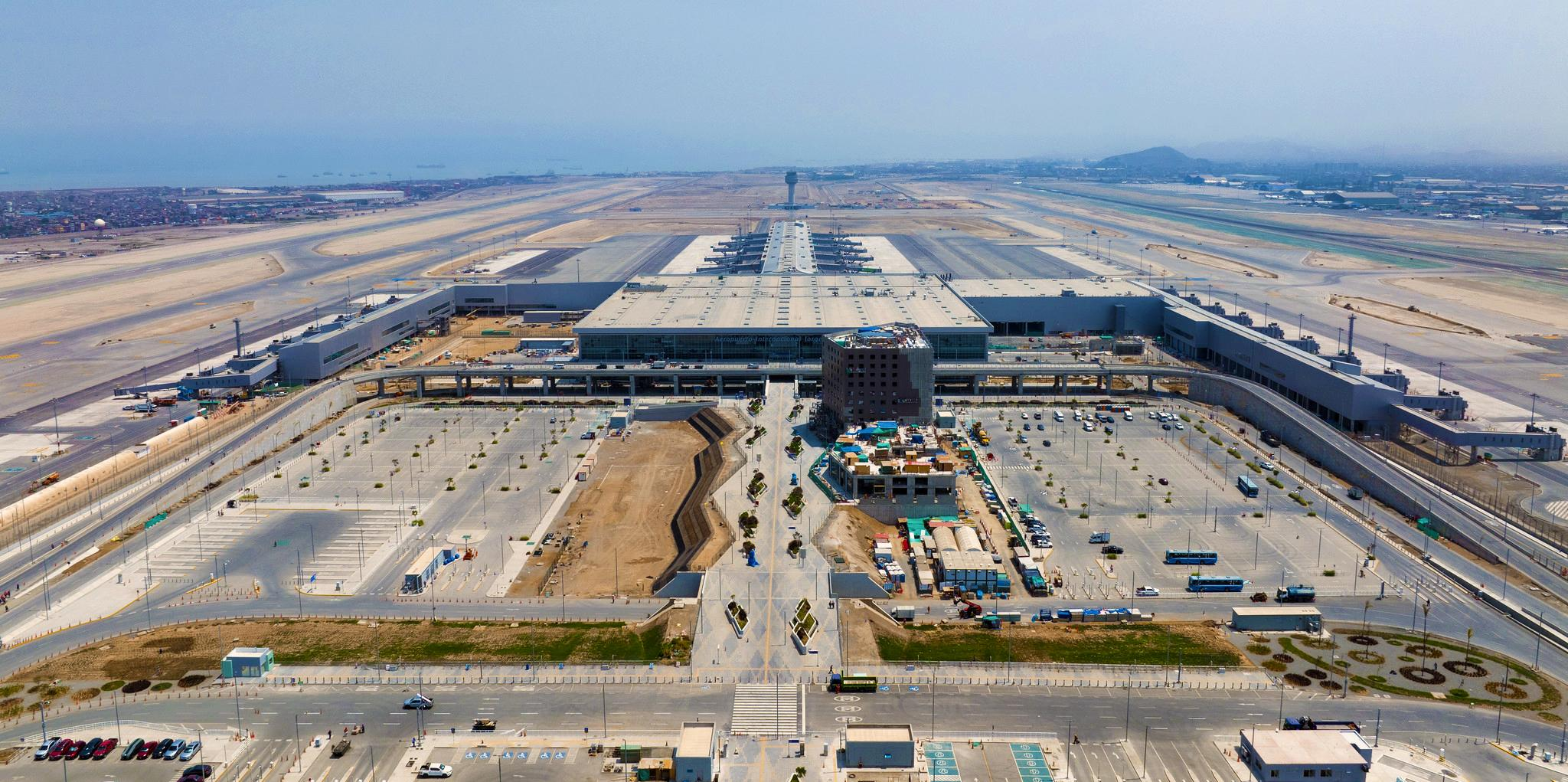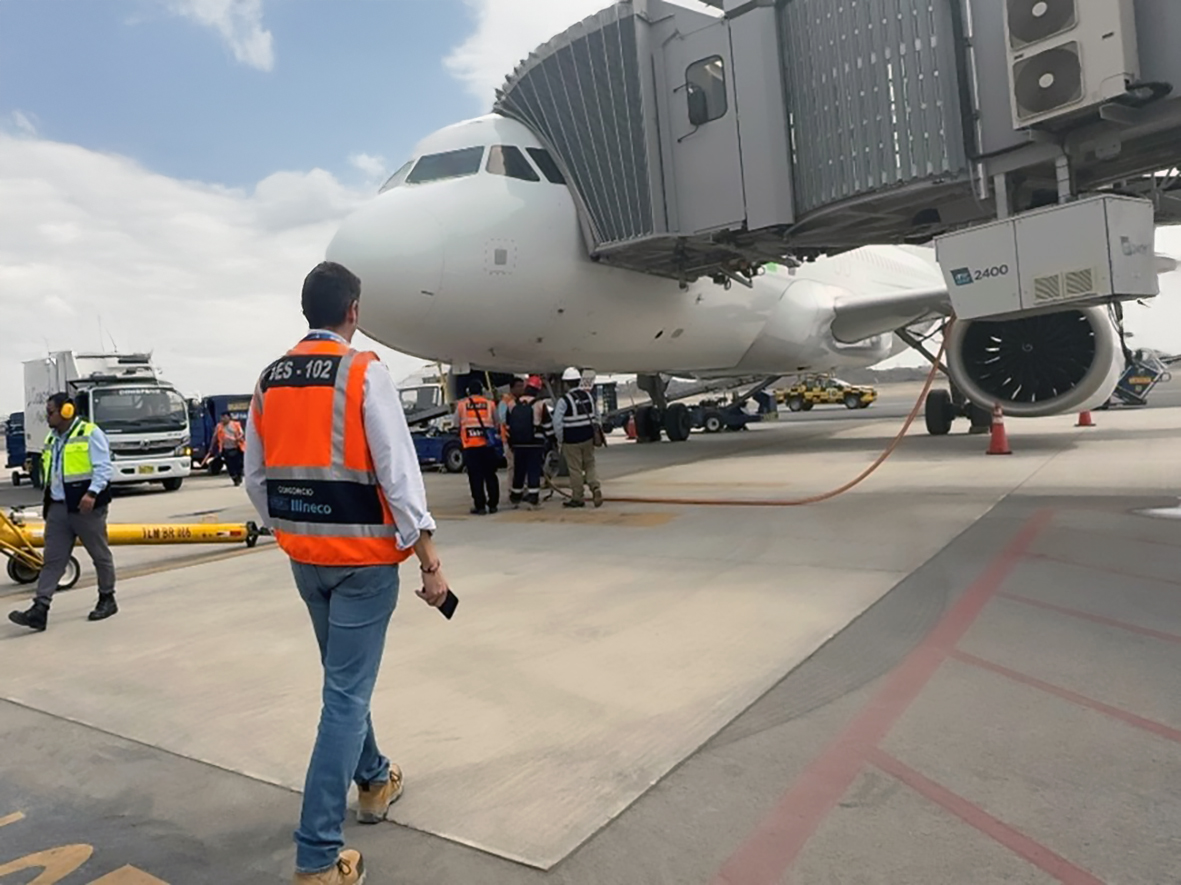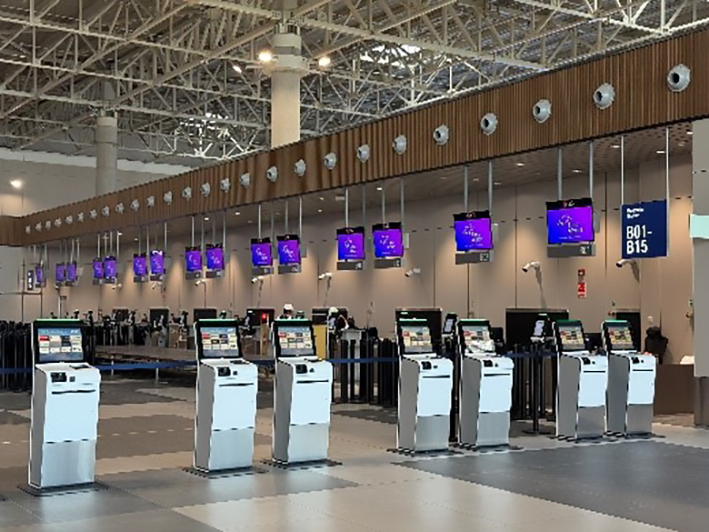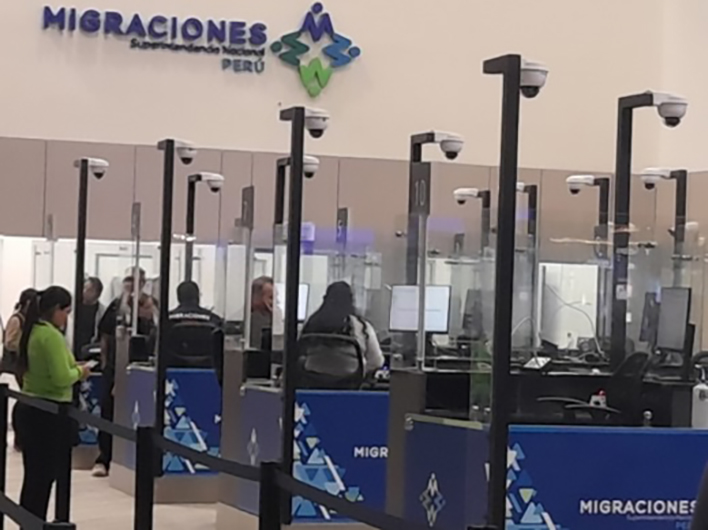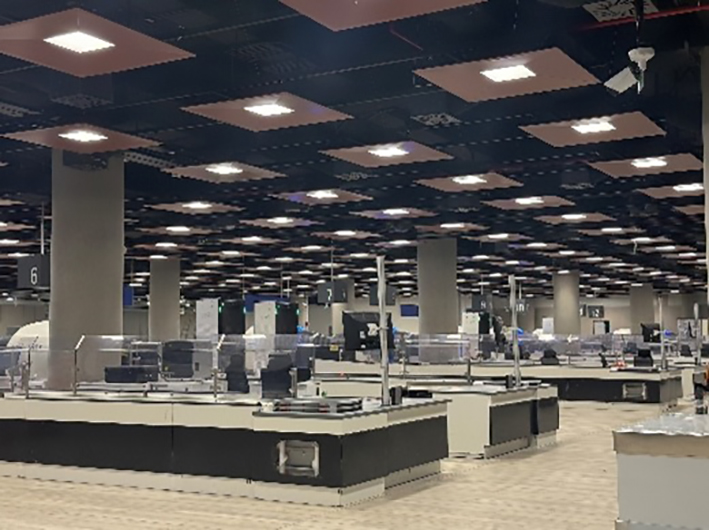01
The Callao hummingbird

Although they are separated by a physical distance of about 440 km and more than 1,800 years in their respective construction dates, the plains of Nazca, in the south of the country, and the Jorge Chávez Airport in Lima, in the province of Callao, shares one of the country's most iconic images, the "great hummingbird", seen from the air. The famous geoglyph has inspired the design of the new terminal, which triples the area of the existing one, and where tests and trials have been conducted over several months with more than 9,000 volunteers acting as passengers with simulated luggage, but faithfully reproducing the real processes of check-in, boarding, security checks, etc.
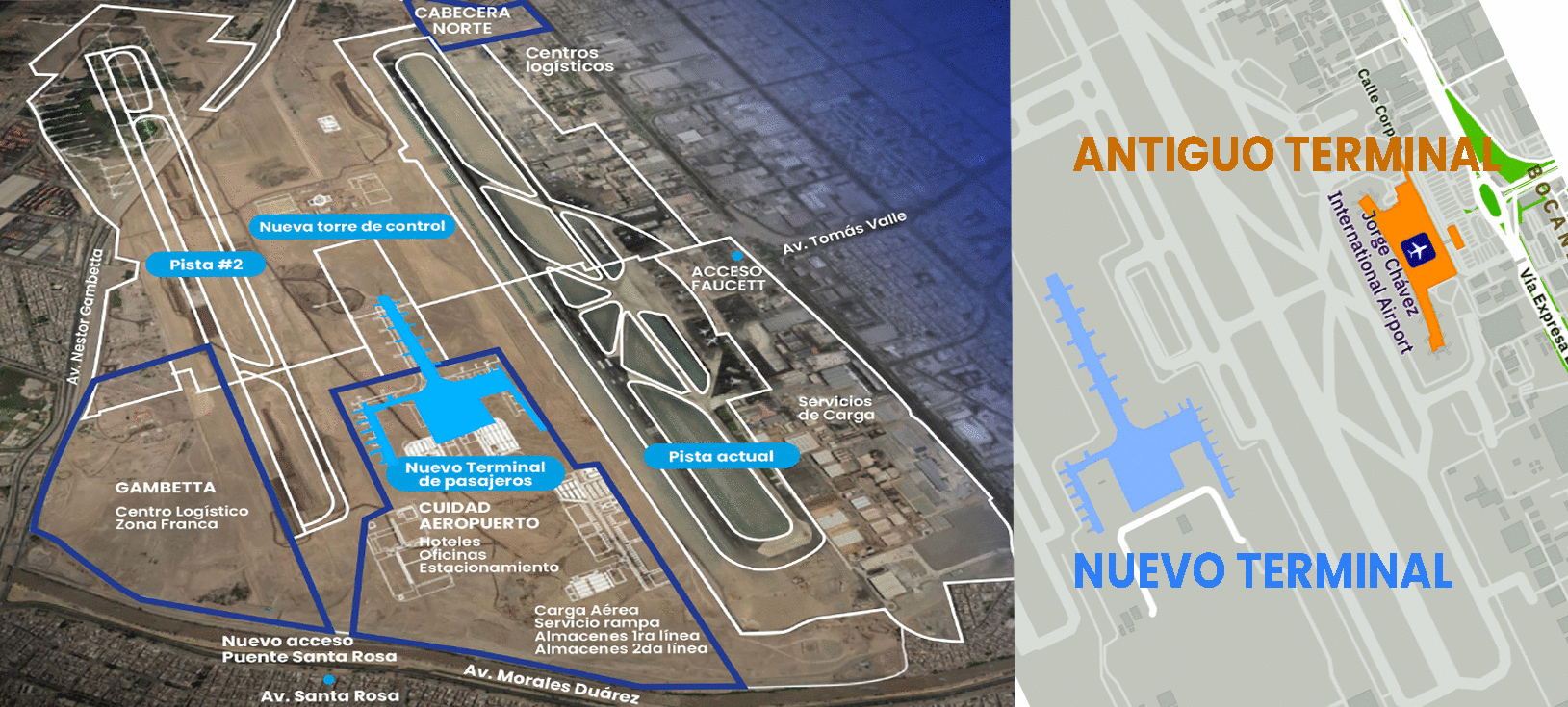
On May 15, the “marcha blanca” (trial phase) or testing period began with real flights. Following the official inauguration on May 30th, the new passenger terminal, spanning over 209,000m2 (more than double the size of the previous one )has now become the heart of the renovated Jorge Chávez Airport. With a projected passenger volume of 24.5 million in 2024 (and an expanded capacity of 30 million following this first phase) official data indicates that it is one of the six busiest airports in Latin America. And from now on it will be even more so, thanks to the expansion planned for January 2026, which will reach an area of almost 270,000 m2 (three times the size of the old terminal) which will increase its capacity to handle the expected traffic in 2030, up to a maximum of 40 million passengers per year.
The expansion also includes the second runway and a new control tower, operational from 2023. They are the main infrastructures of what is in fact already a new airport, a major national project that the Peruvian state launched more than a decade ago and in which Ineco has been participating since 2014, together with the Peruvian engineering company CESEL.
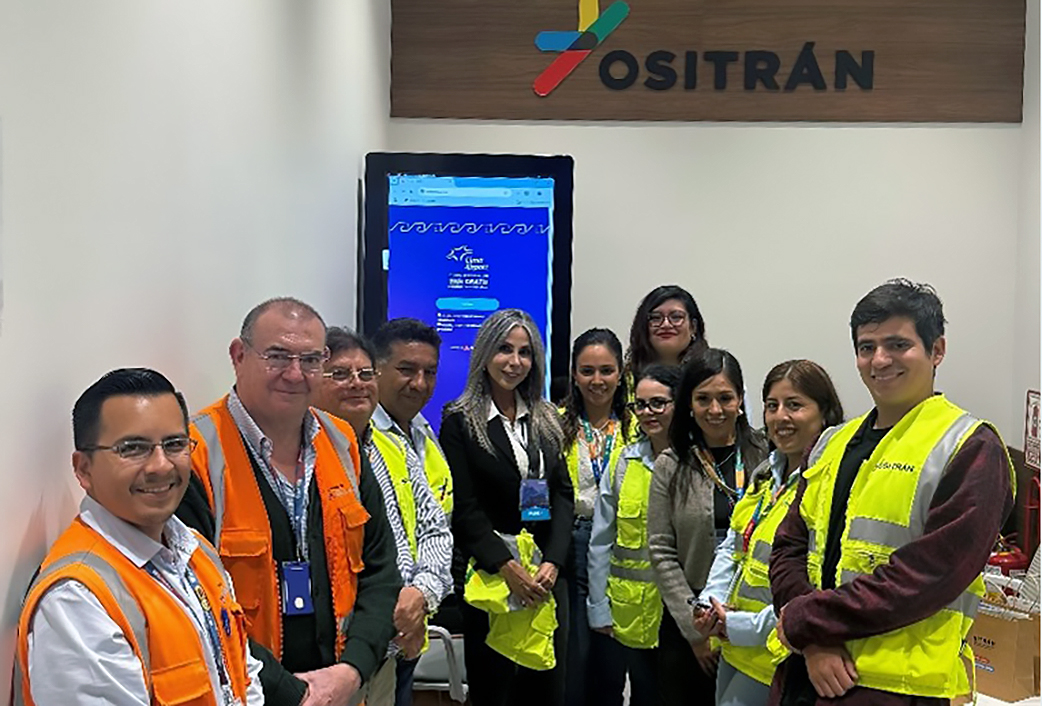
The joint team, consisting of 65 professionals (14 of them from Ineco, mainly specialists), has since been working supervising the improvement works for OSITRAN (Supervisory Agency for Investment in Public Transport Infrastructure, the state regulator of concessioned infrastructures), and in close collaboration with the airport concessionaire, Lima Airport Partners (LAP).
The task of the Ineco and CESEL team is to monitor the execution of the works, divided by the concessionaire into six work packages, managed by different consortia of construction companies.
Although the inauguration of the new terminal, which also introduces a new platform and land access, marks a historic milestone for the country's air transport and the airport, work will continue in the coming months until January 2026 to reach a capacity of 40 million passengers. On the land side, work will also continue on the construction of hotels and commercial and logistics areas. At the same time, the renovation and maintenance of the first runway will progress, among other actions.
The Jorge Chávez, in figures
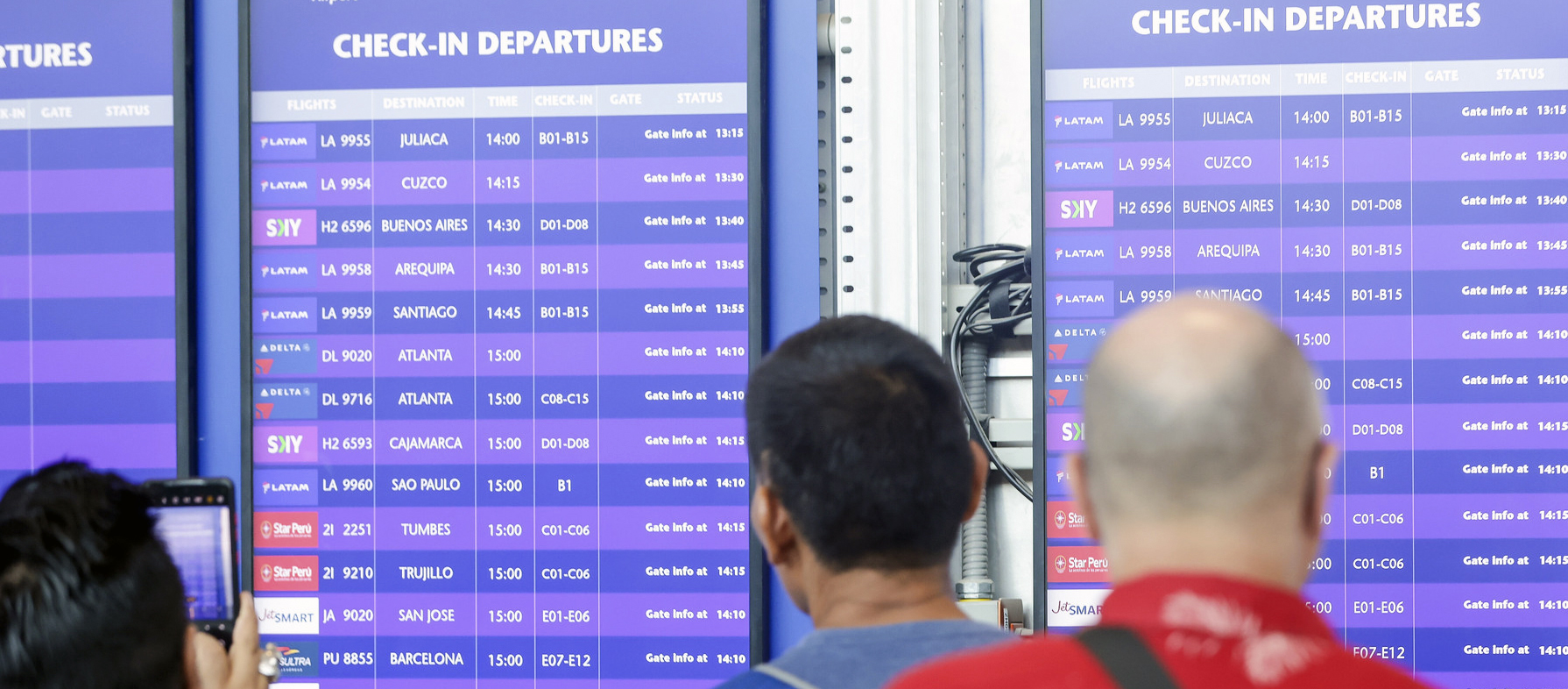
Photo: LAP
- Passenger traffic:
- 2024: 24.5 million, 15.2% more than in 2023, of which
- 9,7 millon are international
- 14,7 millon are nationals
- Forecast for 2025: 30 millon
- Total accumulated growth since 2001: nearly 20 million passengers
- 2024: 24.5 million, 15.2% more than in 2023, of which
- 189.492 aircraft movements (11% more than in 2023)
- 228.960 tonnes of cargo
- 22 airlines
- 60 destinations
- Main international destinations: Santiago de Chile (14%) and Madrid (10%), Miami, Bogotá and Panama
- Main domestic destinations: Cuzco (25%), Arequipa (14%), Piura and Tarapoto
- Operator: In 2001, the government of Peru granted the airport concession for a period of 40 years (extendable for two more periods of 10 years) to the company Lima Airport Partners, 80% owned by Fraport AG (operator of Frankfurt airport and 30 others worldwide) and the International Finance Corporation, part of the World Bank, with the remaining 19.9%. The main conditions of the concession contract are self-financing and the commitment to carry out the expansion.
- Air navigation and traffic control services: Peruvian Corporation of Airports and Commercial Aviation Inc. (CORPAC).
Source: LAP 2024
Source: LAP 2024
02
This is the new terminal
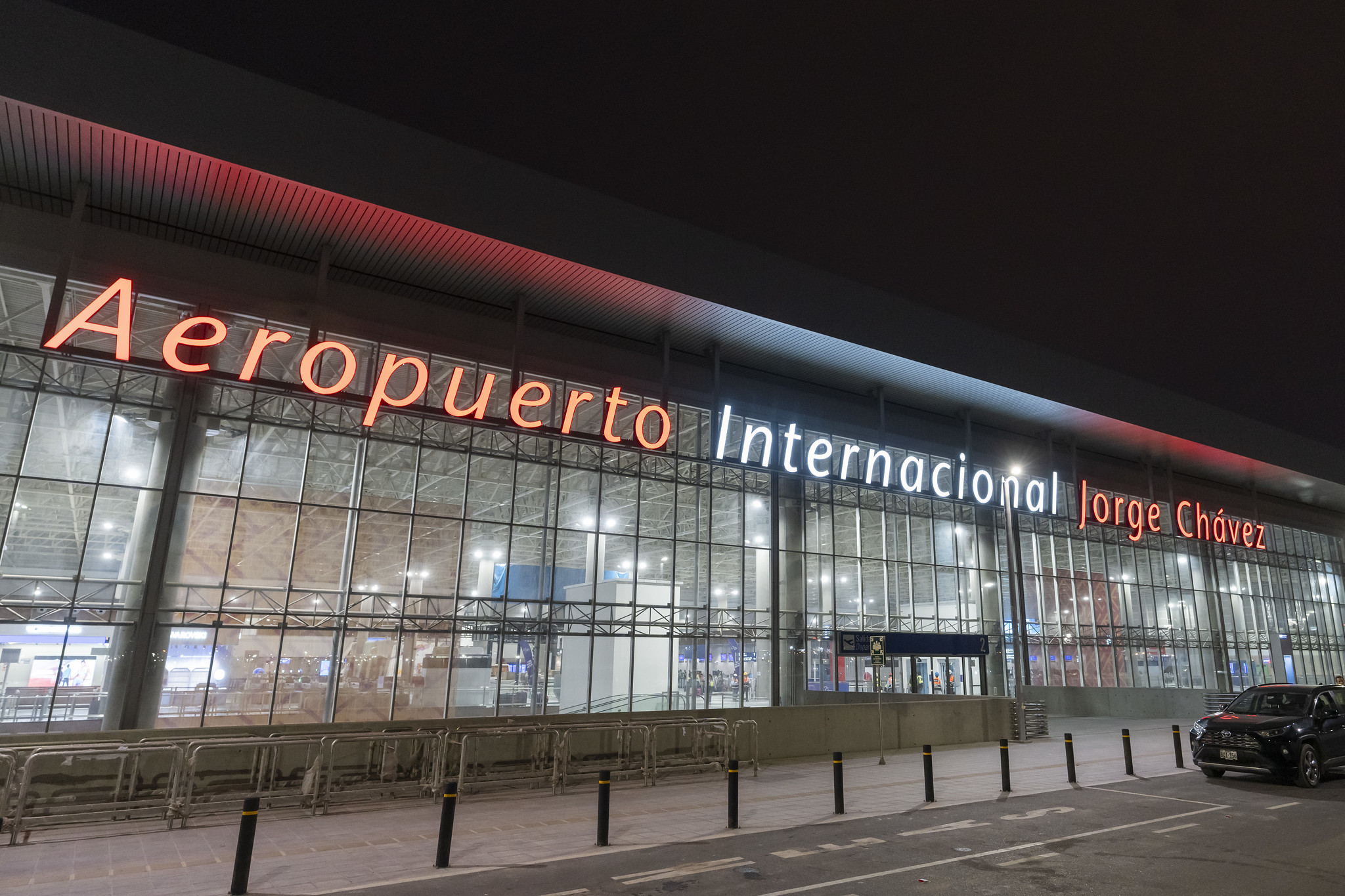
Located between the two runways, the new terminal triples the area of the existing one, with a total of more than 260,000 m2, of which 209,000 m2 have been put into operation.
The building features five floors (four above ground and a basement) an increase of three levels compared to the previous structure. It is equipped with 80 elevators and 35 moving walkways. The first floor houses the arrivals area for both domestic and international flights, along with six baggage claim carousels.
The second floor is also dedicated to arrivals and connecting flights, and it includes a commercial and dining zone.
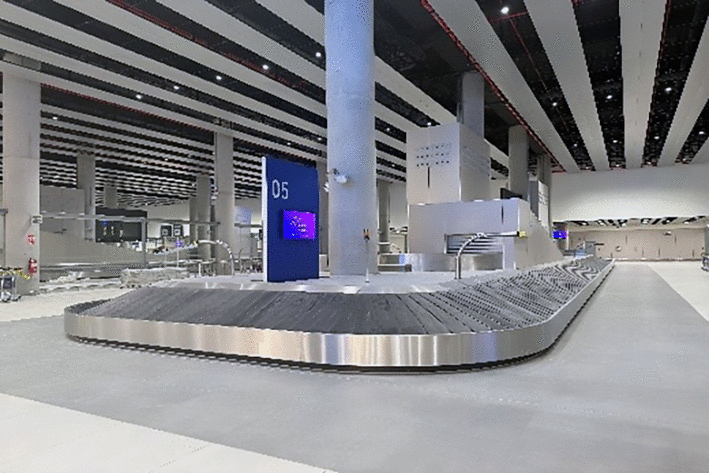
On the third level, there is the departure hall featuring over 90 check-in counters, security controls equipped with 27 state-of-the-art 3D scanners—an upgrade from traditional 2D X-ray machines—and 90 hand luggage inspection modules. The area also includes a 360-degree commercial and duty-free zone, along with the departure lounges decorated with designs inspired by the country's culture and traditions. The upper floor is reserved for VIP and authority rooms, while the basement houses several technical facilities.
Beneath the terminal floor runs the hold baggage handling system, which includes 7 km. conveyor belts that operate, mostly, in an automated manner, and four 3D scanners, with the capacity to process 1,200 pieces of luggage per hour.
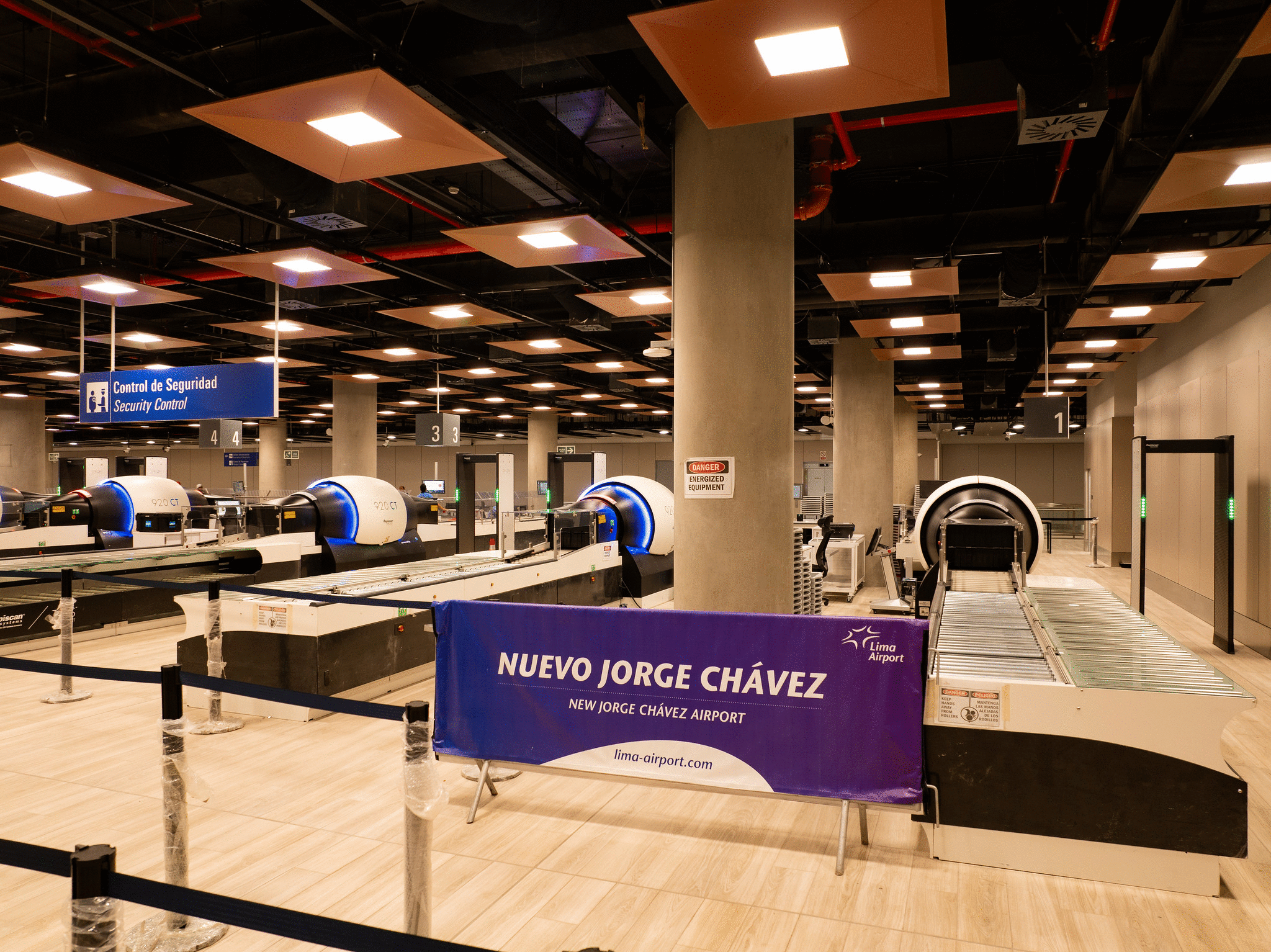
For their part, passengers have 46 boarding bridges, 27 more than in the old terminal. The building has three docks the one on the right for domestic flights, the one on the left for international flights, and the central one for mixed use.
The project includes, in addition to the building, a new aircraft platform of 575,000 m2, with 14 MARS parking spaces and 39 C parking spaces: 2,800 vehicle parking spaces and various auxiliary buildings
In addition, a new road network has been built with more than 1,000 metres. of new roads. From this June, the former access via Avenida Faucett has been closed, and it is now only possible to access the airport via Avenida Morales Duárez. Two temporary bridges have been built until they are concluding the one in Santa Rosa, scheduled for 2027, which is being carried out by the Ministry of Transport and Communications.
Pioneer of the air
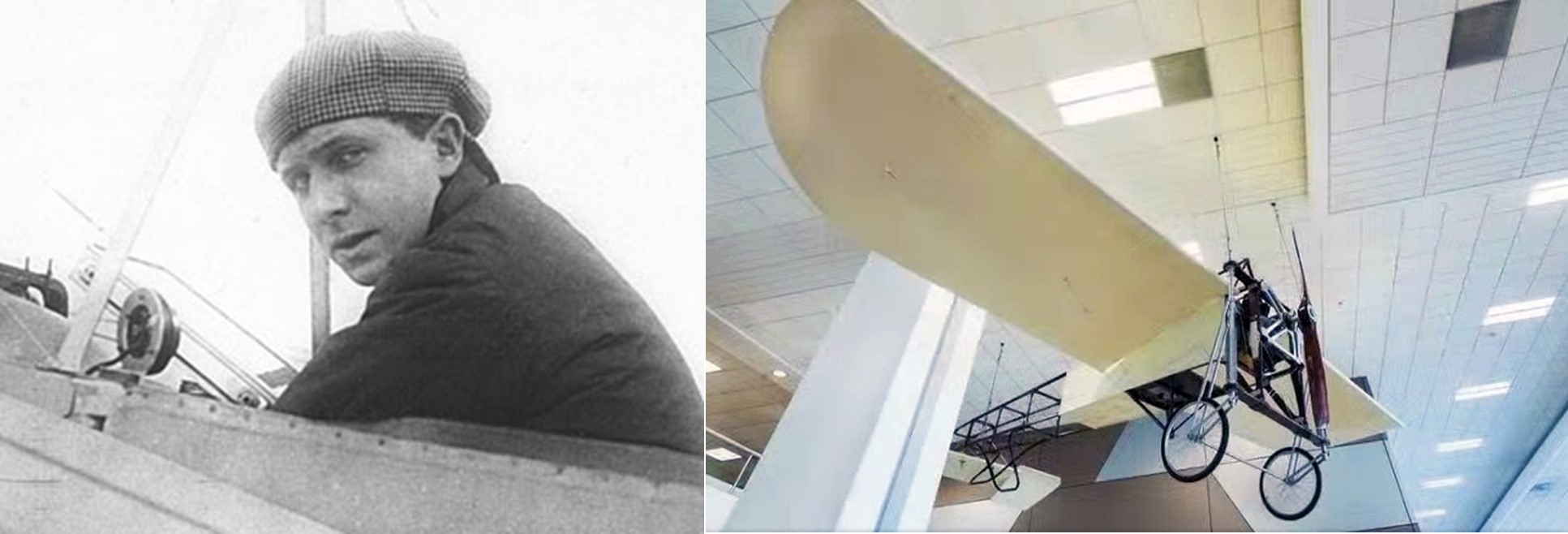
The aviator Jorge Chávez in 1910, four days before flying over the Alps, and a replica of his plane, Blériot XI, displayed in the arrivals hall of the old airport terminal. Photos: Public domain/ LAP
Jorge Chávez International Airport has taken a great leap into the future, following in the footsteps of the aviator from whom it takes its name. In 1910, a 23-year-old Peruvian young engineer residing in Paris, Jorge Antonio Chávez Dartnell, achieved the feat of crossing the Alps aboard a small monoplane made of ash wood, bamboo, and fabric, with an engine of only 25 H.P. which reached 65 km/h. At that time, the nascent aviation was considered a sport (today we would say high-risk) and few foresaw its subsequent development. The aircraft were small and fragile, carrying no more instruments than a compass and an altimeter, and of course, airports did not yet exist.
This did not prevent Chávez, known as "Geo", an enthusiast of sports, from learning to fly in a few weeks and breaking several altitude records in various air competitions (in which he always registered as Peruvian, despite being born in France) before participating in the contest that would bring him worldwide fame. Organised in 1910 by the Aero Club of Italy, it offered a prize of 20,000 dollars for flying over the Alps via the Simplon Pass, from Brigue (Switzerland) to Milan (Italy), a journey of about 150 km.
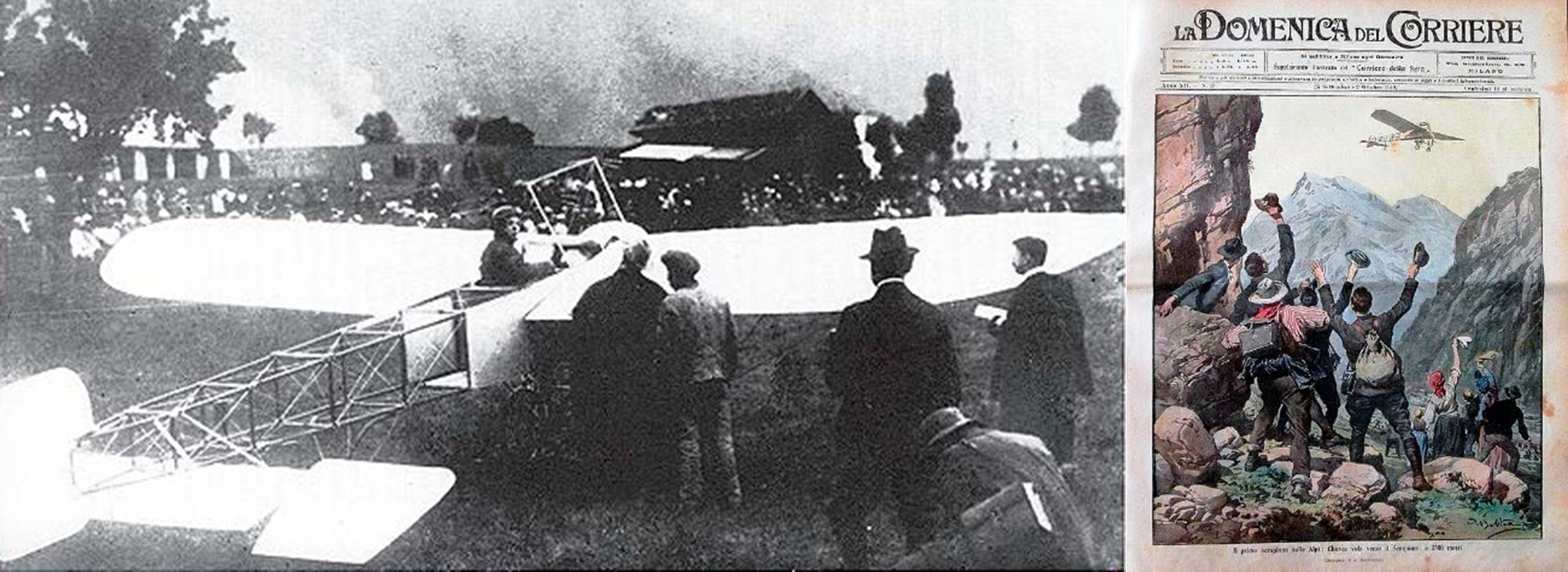
The Peruvian pilot in his aircraft, moments before takeoff from Brigue (Switzerland), and featured on the cover of the Sunday supplement of the Italian newspaper Corriere della Sera in Milan, which recounted the journey. Photos: Archive of the Institute of Aerospace Historical Studies of Peru
"The crossing of the Alps marked an important milestone in the history of world aviation, as it demonstrated that aviation could have multiple applications and great development prospects for nations, which is why Jorge Chávez is considered a pioneer." Hernán Rivas, Institute of Aerospace Historical Studies of Peru, 2022
International press and numerous spectators closely followed the flight, and although he achieved his goal by surpassing 2,000 meters in altitude, as he was already landing in Domodossola (his final stop before reaching Milan) just 20 meters above the ground, the wings of his Blériot XI (designed and built by the French aviator of the same name who had crossed the English Channel) broke apart, causing Chávez to crash. Although it was initially believed that his injuries were not serious, he eventually died after four days.
His remains were repatriated to Peru in 1957, after a large funeral in Paris, and were transferred to the Las Palmas air base in the Peruvian capital, attended by the country's president and other authorities. Eight years later, in addition to other honours and recognitions, the new airport in Lima was named after him, where a replica of his aircraft is preserved, and the Peruvian Air Force adopted the phrase "Arriba, siempre arriba" (Up, always up) as its motto, the last words attributed to him.
03
El viento, la puerta y el sol

Foto: Giancarlo Urrelo -Ineco
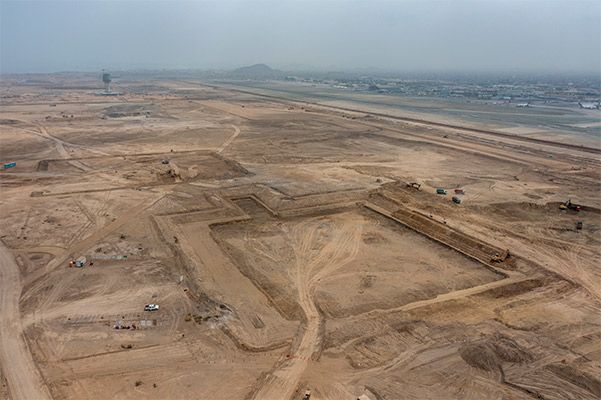
Las obras de ampliación del aeropuerto Jorge Chávez, uno de los proyectos estratégicos del país, se iniciaron en 2014, fecha en que Ineco empezó a desempeñar su labor de supervisión para OSITRAN, el organismo supervisor, mientras que el Ministerio de Transportes y Comunicaciones (MTC) se encargó de expropiar y entregar los terrenos al concesionario LAP, que es quien ha ido adjudicando los diferentes paquetes o lotes en que se dividieron las obras.
El paquete 1 fue adjudicado al consorcio Nuevo Limatambo,( en referencia al nombre del primer aeropuerto de Lima). Formado por la peruana COSAPI y la española OHL, se encargó de los trabajos previos de preparación del terreno para la construcción, lo que incluyó el movimiento de 2 millones de m3 de tierra, labores de limpieza, desbroce, rescate biológico y demoliciones en una superficie de 600 hectáreas.
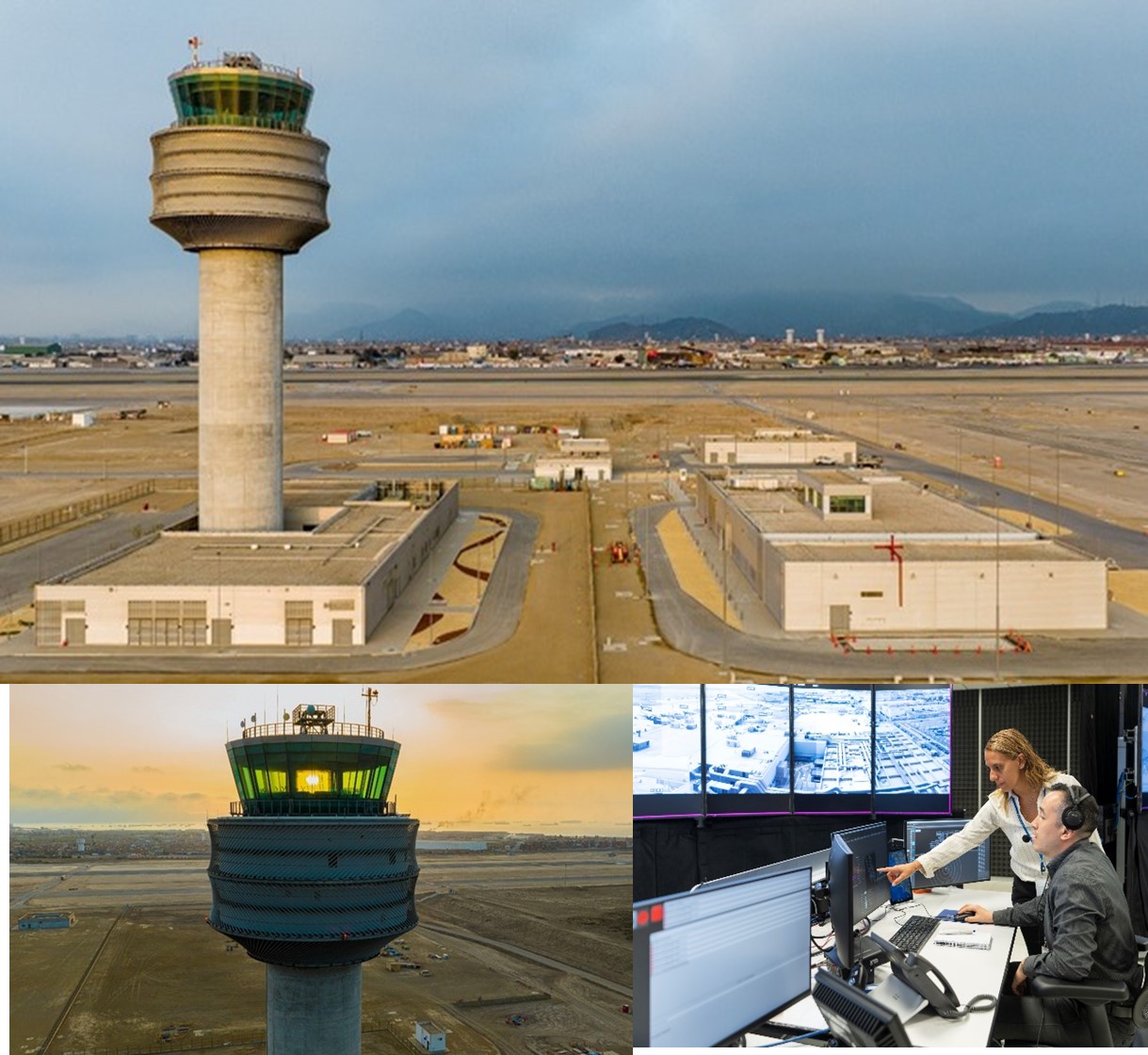
Entre los principales, figuran los dos del lado aire. El paquete 2.1 se adjudicó al consorcio Wayra (“viento”, en quechua), formado por Ferrovial Construcción, Acciona y la constructora local JJC, seleccionado por LAP en 2020 para ejecutar la nueva torre de control , de 65 metros de altura (equivalente a un edificio de 21 pisos) y edificio auxiliar, y otras edificaciones: SEI ( extinción de incendios) , sala de reguladores, central eléctrica, centros de transformación… CORPAC se encargó de implementar los sistemas de navegación aérea, así como de la capacitación de los controladores.
La torre, construida en hormigón armado y acero, cuenta con 10 puestos de control. El lote incluía también la construcción de un edificio de servicios, un centro de regulación y transformación que alberga el sistema de balizamiento; un edificio para el servicio de extinción de incendios y otro para el control de fauna, así como la red de alcantarillado y de agua potable. En total, la torre más los edificios auxiliares ocupan una superficie total de 3.100 m2.
El segundo lote de trabajos en el lado aire fue adjudicado al consorcio Inti Punku (“Puerta del Sol”, en quechua, en referencia a Macchu Picchu), formado por la española Sacyr Infraestructuras y la constructora peruana Cumbra. Los trabajos incluían la ejecución de una segunda pista de 3.480 metros, más de 10 km de calles de rodaje, con los correspondientes sistemas de luces de aproximación y balizamiento.
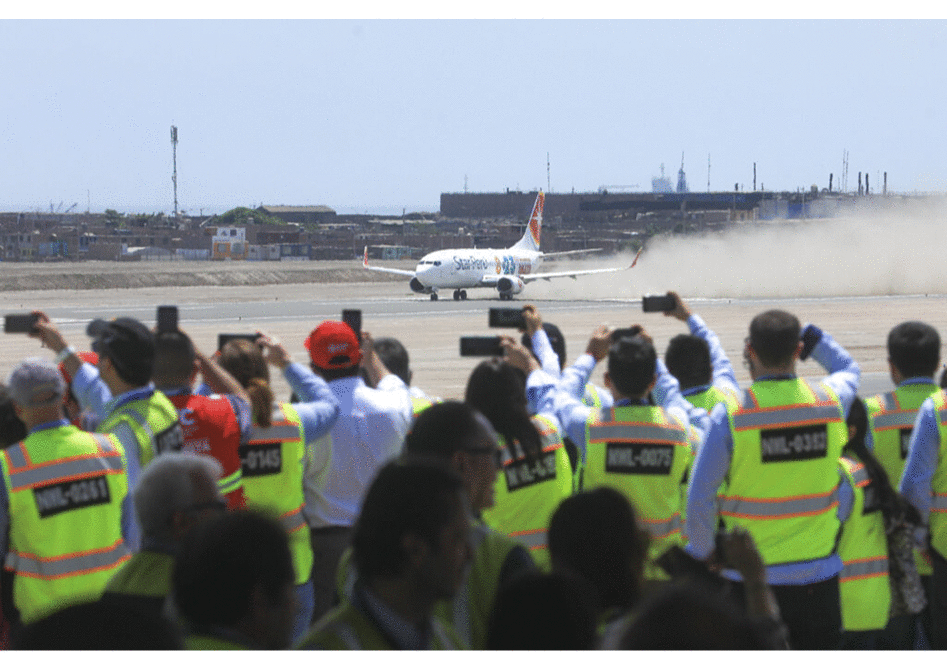
Finalmente, en 2022 se licitó el tercer paquete de obras, correspondiente al nuevo terminal, plataforma y accesos, adjudicado también a Inti Punku.
Los procesos ORAT (Operational Readiness and Transfer, puesta en marcha y transición operativa), para la puesta en explotación de las nuevas instalaciones fueron desarrollados desde 2023 por expertos de Fraport, socio mayoritario de LAP. Consisten en la familiarización del personal con las nuevas instalaciones, ensayos y pruebas de todos los procesos aeroportuarios, , con la participación de todos los agentes implicados.
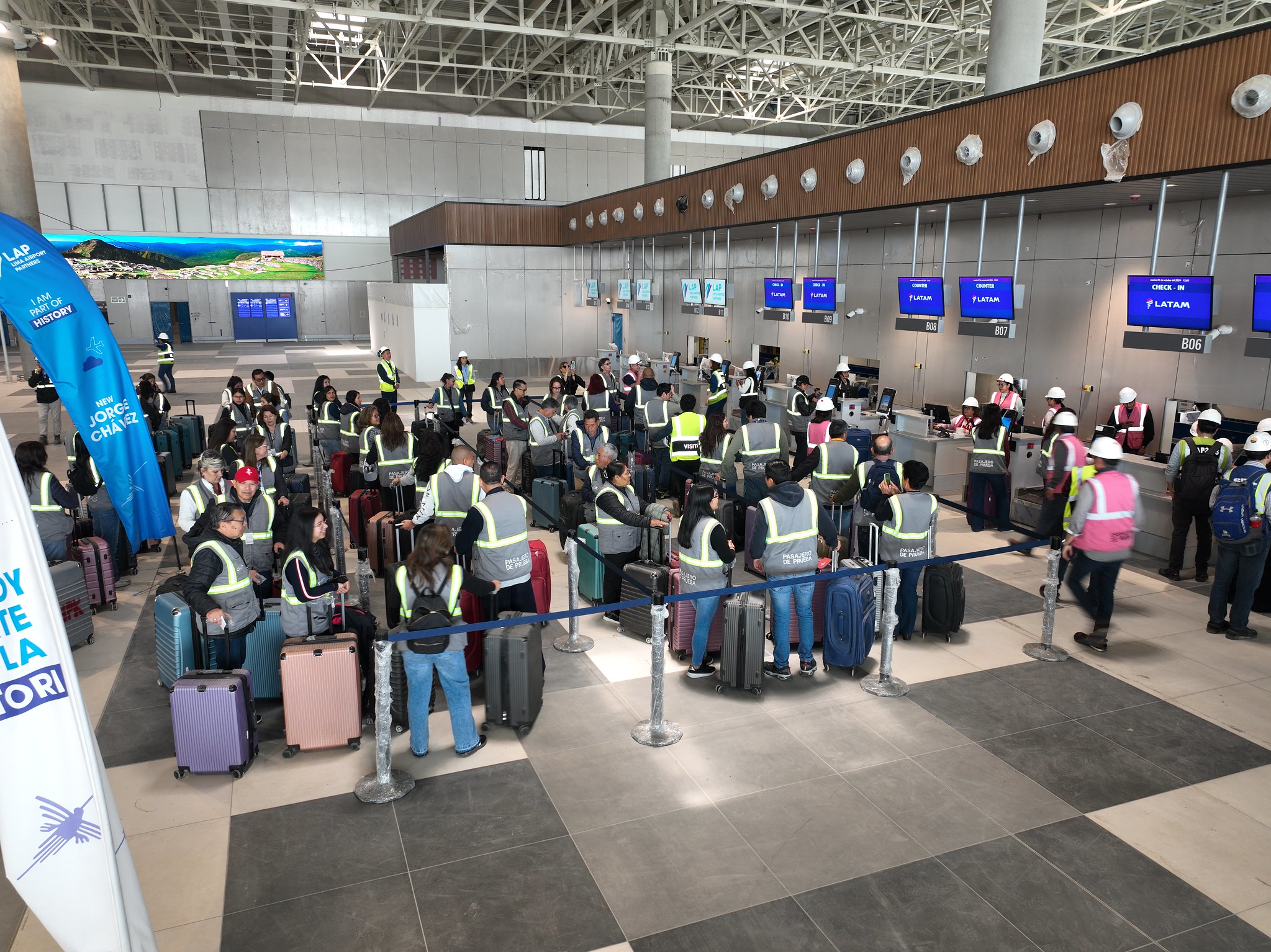
Las obras sacaron a la luz vestigios arqueológicos de diferentes épocas (prehispánicas, colonial y republicana, datadas entre 200 d.C hasta los 1460 d.C) como fragmentos de cerámica, esculturas, urnas funerarias, cuentas de collares o enseres domésticos, entre otras. En total se encontraron 75 piezas, de las que 59 han sido declaradas Patrimonio Cultural nacional, que han sido restauradas y preparadas para su conservación o exhibición. En 2021 se inauguró en el aeropuerto un Centro de Interpretación Arqueológica, abierto al público, donde se exhiben algunas de ellas .
Hitos del proyecto de ampliación

Parte del equipo de Ineco y Cesel en el aeropuerto, en octubre de 2014. Foto: Ineco
- 2001 Se transfiere al actual concesionario, LAP, por un periodo de 40 años, más dos prórrogas de 10 años cada una
- 2004 LAP lleva a cabo diversas mejoras
- 2013 El Ministerio de Transportes y Comunicaciones (MTC) entrega al concesionario los primeros terrenos expropiados para la ampliación, alrededor de un millón de m2
- 2014 Ineco, en consorcio con CESEL, inicia la supervisión de las obras de ampliación para OSITRAN
- 2016-2019 Se detienen los trabajos mientras se tramitan las expropiaciones
- 2018 Acta de entrega del 100% de los terrenos, unos 6.000.000 m2
- 2019 Se inician trabajos preparatorios para la construcción: limpieza del terreno, remediación ambiental, campañas de hidrogeología, geotecnia y rescate biológico.
- 2020 Julio: se inicia la construcción de la nueva torre de control y los edificios auxiliares
- 2021 Febrero: inicio del proceso de licitación para la construcción del nuevo terminal de pasajeros
- 2022 Se terminan la nueva torre de control y la segunda pista de aterrizaje y se entregan a CORPAC para la implementación de equipos de aeronavegación.
- 2023 Abril: Inauguración oficial y comienzo de la progresiva entrada en operación de la segunda pista y la torre.
- 2024 Septiembre-octubre: Se sustituyen los 33 paneles de vidrio del fanal de la torre de control tras detectarse problemas de distorsión.
- 2025 El 30 de mayo se inauguran el nuevo terminal, plataforma y accesos
04
Adelante, siempre adelante
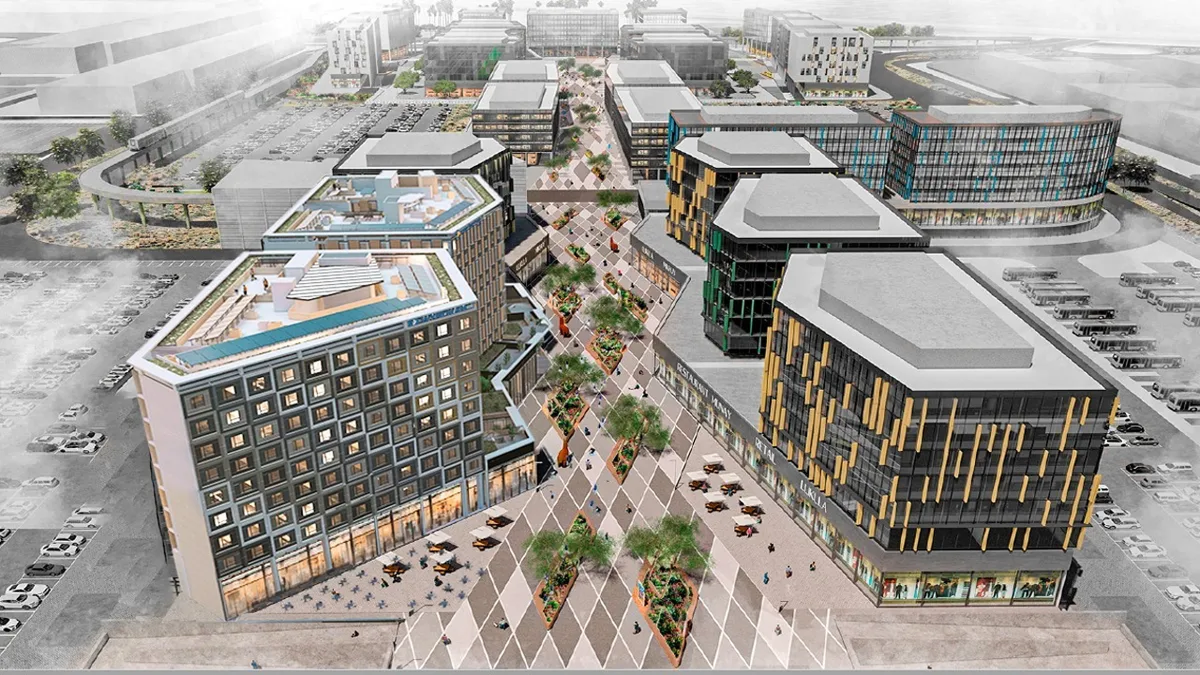
La ampliación ha abierto una nueva etapa de la historia del Jorge Chávez, que empezó en 1960, al inaugurarse con el nombre de Lima-Callao, cambiado en 1965 por el actual. Situado a unos 12 km de la ciudad, sustituía al de Limatambo, que se encontraba en lo que hoy es el distrito de San Isidro, centro financiero de la ciudad.
El aeropuerto de Lima es un gran motor económico para la provincia de Callo y para el conjunto del país. Genera 90.000 puestos de trabajo directos e indirectos según el concesionario LAP. Una cifra que se prevé elevar hasta 121.000 en 2025, ejercicio en el que aportará al Estado 500 millones de dólares en impuestos.
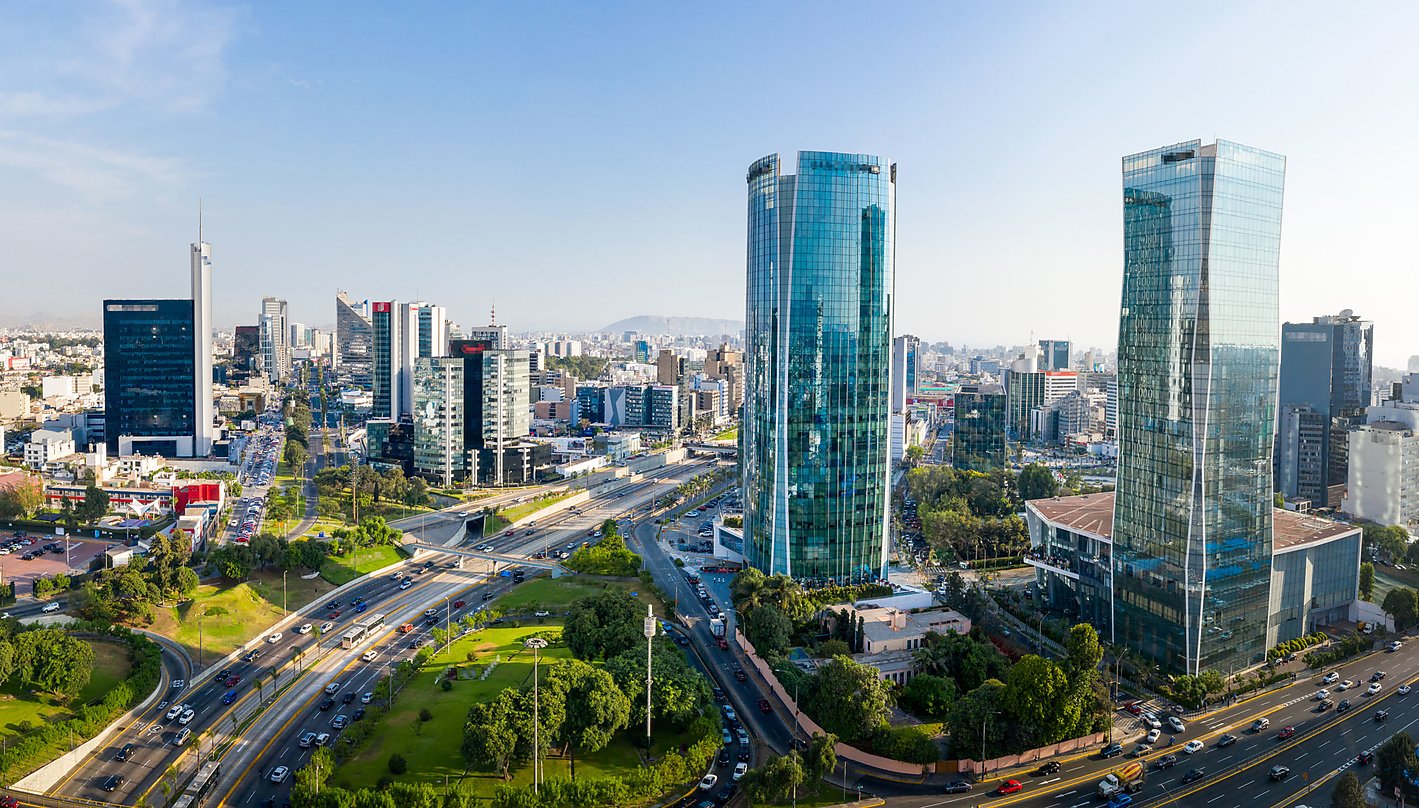
Y es que la ampliación es el proyecto nacional de mayor inversión -2.400 millones de dólares en total- , tras la nueva línea 2 del Metro de Lima y Callao. Y hay planes a medio y largo plazo para rentabilizarla y seguir creciendo, incluyendo la reutilización del antiguo terminal.
Así, el concesionario ha previsto el progresivo desarrollo y comercialización de un total de cuatro grandes parcelas para hoteles, carga, logística y otros servicios, hasta 2041, fecha inicial de fin de la concesión. El proyecto, denominado “Ciudad Aeropuerto”, busca aprovechar la cercanía del puerto del Callao, el mayor de Perú , del que dista tan sólo 2 km., para impulsar las mercancías aéreas y los servicios asociados. Actualmente el Jorge Chávez ocupa el octavo puesto de Latinoamérica en carga aérea , con casi 230.000 toneladas de carga en 2024.
Ineco en Perú
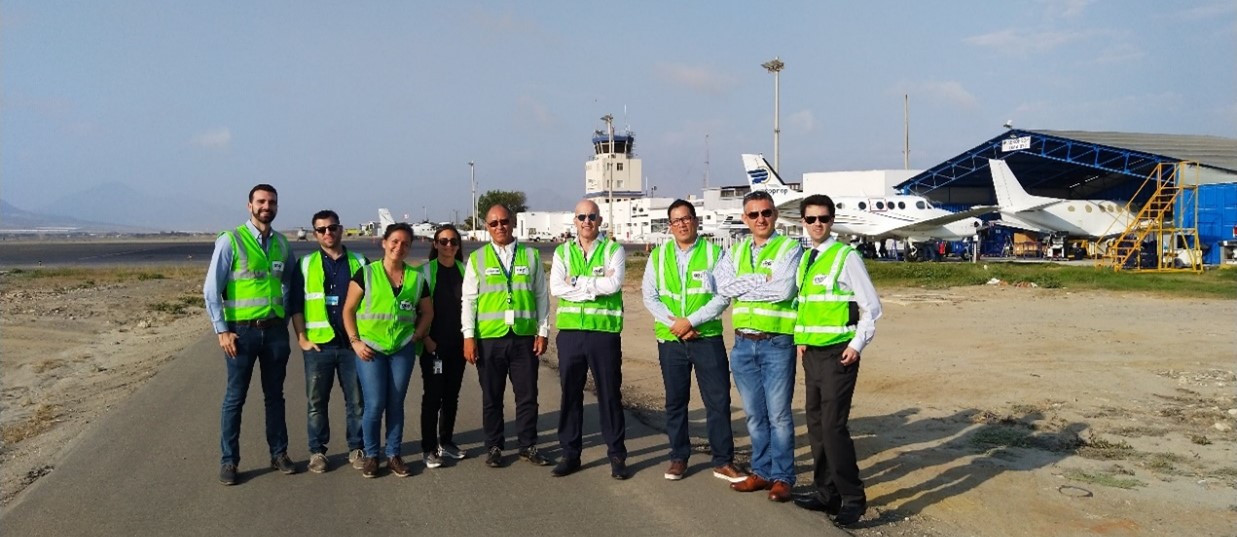
Personal de Ineco en el aeropuerto de Trujillo. Foto: Guillermo Vich-Ineco
Los primeros trabajos de Ineco en Perú se remontan a los comienzos de la compañía, fundamentalmente estudios de consultoría ferroviaria, como las “Consideraciones básicas para el establecimiento de un plan integrado de transporte en la república del Perú”, de 1970. Ya en los 90, trabaja durante 4 años en el Proyecto Libertadores, impulsado por el gobierno español, (1990-94), un estudio para integrar las redes ferroviarias de Argentina, Bolivia, Brasil, Chile, Paraguay, Perú y Uruguay mediante obras de mejora en cuatro grandes corredores.
En 2014 la compañía abrió una sucursal en Perú y además de la supervisión del Jorge Chávez, participa en otros proyectos de ampliación de aeropuertos en el país. Junto con CESEL elaboró los estudios de preinversión para la modernización del aeropuerto de Chiclayo, (2015-17). Con CEMOSA llevó a cabo el proyecto constructivo y realizó el seguimiento en la fase de licitación de la ampliación del aeropuerto de Trujillo (2020), que incluía nuevas terminales de pasajeros y carga, la ampliación de la plataforma y calles de rodaje, y nuevas instalaciones auxiliares.
Además de sus trabajos en aeropuertos, en el ámbito ferroviario destaca el estudio de viabilidad del Corredor Ferroviario Bioceánico Central (CFBC) para unir Perú, Bolivia, Chile y Brasil, que llevó a cabo en consorcio con Incosa (2017)
Actualmente, participa en otro gran proyecto nacional: el EDI (Estudio Definitivo de Ingeniería) de la Nueva Carretera Central, de 185 kilómetros, que unirá Lima Metropolitana con la Macro Región Centro Amazónica. La compañía lidera el consorcio formado por IDOM, Geoconsult, Carlos Fernández Casado, Hualca Ingenieros y Arenas y Asociados.


